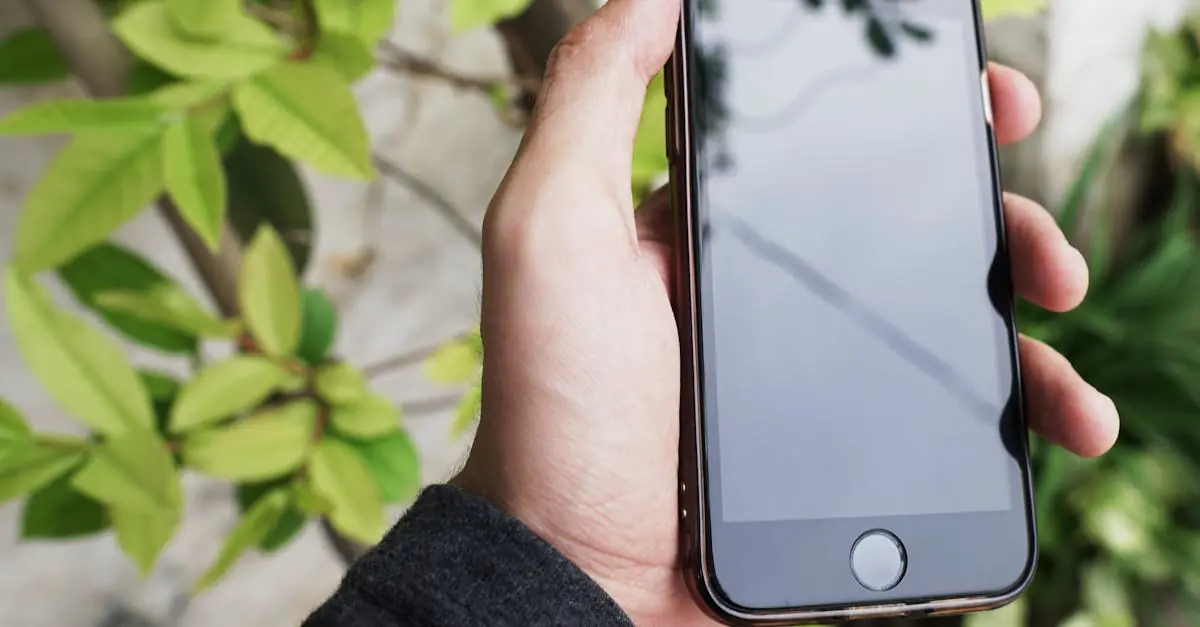Losing an iPhone can feel like losing a part of yourself. It’s not just a phone; it’s a vault of memories, memes, and maybe a few embarrassing selfies. But what happens when that trusty device goes dark? Can you really track down an iPhone that’s turned off, or is it just a lost cause like your last New Year’s resolution?
The good news is, you’re not completely out of luck. While it’s true that finding a powered-down phone can be trickier than locating a needle in a haystack, there are still some tricks up your sleeve. With a little know-how and the right tools, you might just be able to bring your beloved device back from the abyss. Let’s dive into the ins and outs of tracking down that elusive iPhone, even when it’s playing hard to get.
Table of Contents
ToggleUnderstanding iPhone Location Services
iPhone location services utilize various technologies to determine device locations. GPS, Wi-Fi, and cellular networks work together to provide accurate positioning.
How iPhone Location Services Work
Location services rely on a combination of global positioning data and local network signals. GPS offers precise location information outdoors, while Wi-Fi networks help pinpoint locations indoors. Cell towers also assist by triangulating positions based on network signals. Each method contributes valuable data, enhancing the overall accuracy of location tracking.
Importance of Find My iPhone
Find My iPhone plays a crucial role in locating lost devices. This feature allows users to track their iPhones on a map, even when the device is powered off. An offline iPhone can still show its last known location, enabling users to search effectively. Activation of Find My iPhone enhances security and offers options to remotely lock or erase the device. This tool significantly increases the chances of recovery, making it an essential part of iPhone ownership.
Can You Find an iPhone That Is Turned Off?
Finding an iPhone that’s turned off poses challenges. While tracking a powered-down device is difficult, some methods may yield results.
Limitations of Tracking a Turned Off iPhone
Location services on a turned-off iPhone cannot function. When the device loses power, it no longer communicates with GPS, Wi-Fi, or cellular networks. Without power, the last known location may remain available through Find My iPhone. Users can access this feature through the iCloud website or the Find My app, but it only displays the last position prior to the device shutting down. Additionally, tracking can become unreliable if the device was turned off for an extended period. As a result, recovery efforts require reliance on alternative means.
Scenarios Where Location Might Still Be Available
Certain scenarios could provide location information for a turned-off iPhone. If the device is moments away from losing power, it may send its last location to iCloud. When using Find My iPhone, users may receive notifications that include this last known position. A new feature called Send Last Location automatically transmits location data before the battery dies. Accessing this information allows users to develop recovery plans. Furthermore, if the iPhone reconnects to a power source, it can update its location via the Find My app, potentially assisting in tracking efforts.
Alternative Ways to Locate Your iPhone
Several options may help locate an iPhone, even when it’s turned off. These strategies can enhance the chances of recovery.
Using Recent Locations
Recent locations stored in the location services can be invaluable in tracking a lost device. Accessing these locations requires opening the Settings app on connecting devices. Viewing location history occurs under Privacy and Location Services. Users may find the last known location of their iPhone displayed on the map, offering a potential area to search. This data also shows the time certain locations were recorded, indicating whether it’s worth checking now or revisiting later.
Utilizing Other Apple Devices
Other Apple devices can assist in locating a lost iPhone quite effectively. Leveraging the Find My app on an iPad or Mac enables users to locate their iPhone easily. Users simply need to sign in with the same Apple ID. This process allows them to display their iPhone’s last known whereabouts on a map. Additionally, activating Play Sound prompts the iPhone to emit a noise if it is nearby, enabling users to find it quickly if it is hidden under cushions or in another room.
Tips for Preventing iPhone Loss
Taking proactive steps can minimize the risk of losing an iPhone. Implementing security measures enhances device safety and trackability.
Enabling Find My iPhone
Activating Find My iPhone is crucial for locating the device. Users can enable this feature in the Settings app under their Apple ID by selecting iCloud. This service provides real-time tracking, even if the device is turned off, by showing its last known location. Notifications alert users when an iPhone is found. To maximize the benefits, ensure the option Send Last Location is turned on. This feature sends the iPhone’s final location before the battery dies, increasing the chances of recovery.
Best Practices for iPhone Security
Practicing good security habits strengthens iPhone protection. Regularly updating the iOS ensures users receive the latest security fixes. Choosing a strong passcode protects personal data from unauthorized access. Users should also activate two-factor authentication for added security. Taking the time to back up data via iCloud or a computer means users can restore information if the device is lost. Additionally, keeping track of physical surroundings helps users stay aware of the device’s location while out and about.
Losing an iPhone can be a distressing experience but understanding how to locate it—even when it’s turned off—can provide some peace of mind. Utilizing features like Find My iPhone and Send Last Location can significantly enhance recovery chances. By being proactive and adopting best practices for device security, users can minimize the risk of losing their phones altogether. Whether through recent location data or leveraging other Apple devices, there are ways to navigate the challenges of tracking a powered-down iPhone. Taking these steps not only aids in recovery but also reinforces the importance of safeguarding personal memories and information stored within the device.




